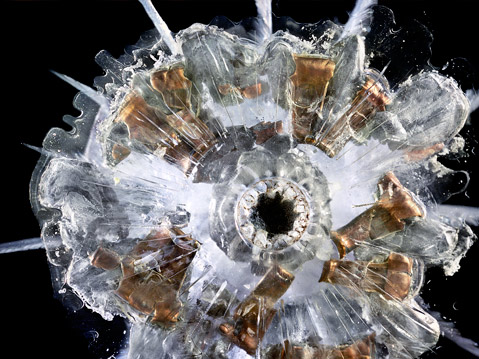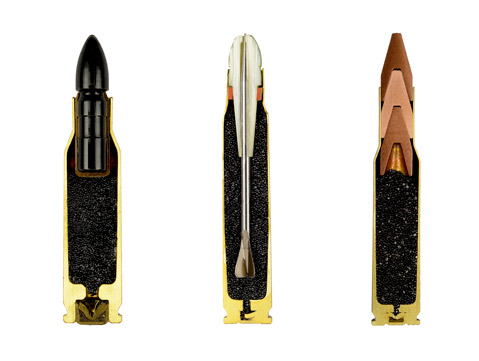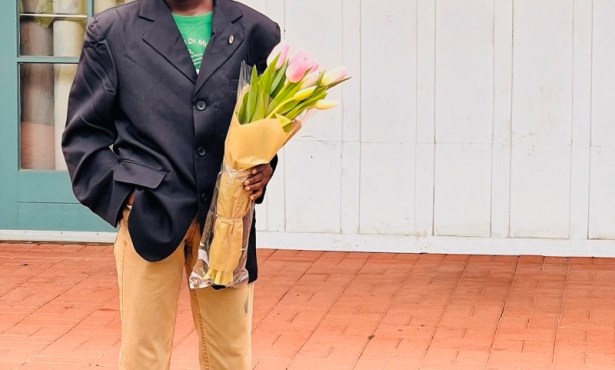Internal Ballistics at Wall Space Gallery
Photos that Stop Bullets

Photography comes alive in the dynamic tension between what’s been photographed and how the image is made. Internal Ballistics, the current show at wall space gallery featuring Deborah Bay and Sabine Pearlman, captures this tension in two series of images dealing with the business end of firearms — the ammo. Bay calls her series The Big Bang. In her studio, Bay has photographed bullet holes of all different calibers and styles that have been shot into Plexiglas, and then blown the images up to many times their original size. At this scale, Bay’s bullet holes become so visually rich that they can be hard to recognize. People have mistaken them for nebulae — images from outer space.
Pearlman documents her ammo before it has been shot, close-up and in cross section. Pearlman’s pristine views have none of the chaos and scatter effects that define Bay’s points of impact. Instead they are all about the organization of destructive energy in potential. Seen at rest, with their strike points, charges, and payloads laid bare, these projectiles once again come as a shock. The first question they raise is, “How many kinds of bullets are there?” and the sinister answer that quickly follows is, “More than you can imagine.”

Taken together, these spectacular and highly pleasurable images foreground a dark paradox at the heart of gun culture. What makes people yearn for more ways of killing — particularly of killing each other — than they could possibly need? Yet seeing the intricacy of these machines of destruction in tandem with the galaxies of flashing energy released by their impact can induce wonder even in committed gun-control advocates.
In order to try to capture a little more of what’s so interesting about Internal Ballistics, I contacted both artists — Deborah Bay by phone from her home in Houston, Texas, and Sabine Pearlman by email. Below are some highlights from those conversations.
The cross-section approach is clearly what makes the ammo series so special. Besides your aesthetic appreciation of their variety, what else does the view into the way these bullets work say to you?
SP: To me, they are the intersection of stunning beauty, frightening amorality, exquisitely lethal, exacting craftsmanship, and a whole host of other contradictions. The surprising anatomy and beauty of cross sections reflects a world of intention back at us. It’s a look under the hood, by which you come to realize that each design is very goal-oriented. With some of them, it’s like getting a glimpse into the psychology of warfare. The images are mesmerizing and also tragic. Photographing the rounds against a clean white background was important to me, to give the ammunition integrity — a life apart from the things people do with them.
Why do you think people have made so many different kinds of bullets?
SP: The variety of different cartridges out there is truly astonishing. Each cartridge is used for a different purpose, e.g. hunting, combat, target practice, self-defense, crowd control, etc. Certain rounds are specifically designed for use on planes — they can hurt a person but won’t puncture an aircraft. Other rounds fall into the category of “obstacle-reduction,” crafted to destroy particularly hard rock, vehicles, or buildings. Armor-piercing rounds fall under the category of “anti-personnel ammunition.” The list goes on and on, reflecting a multitude of desired results for an endless variety of scenarios.
How does the absence of the gun from your images work? Are gun people surprised that someone who is so interested in bullets isn’t more interested in guns?
SP: The ammunition is what’s hidden — it’s what you don’t usually get to see. It’s unfamiliar territory and therefore, to me, more interesting subject matter. I’m really not sure about what other people think, but I’m always happy when my images provide a ticket to talk rather than a clear-cut answer.
When you first saw a cross section of a bullet, did you want to photograph it, or did it take seeing that there were so many different kinds?
SP: Both. I was captivated when I first saw a cross section, and even more so when I found out about the abundance and variety of ammunition.
When did you first get the idea for these images?
DB: I was buying Plexiglas in Houston. There was a display in the store that was intended for customers who were interested in buying bullet-proof Plexiglas for drive-through windows or tellers. So it showed the way that the bulletproof Plexi could stop bullets by showing the impact, and I was fascinated by the forms. It was intriguing to me to see the fragments of metal the bullets left in the surface. It was a blazing hot Texas day, but I asked the manager if I could borrow one of the shot-up pieces for a few minutes. I took it into the parking lot, popped the trunk, put it in there to shade it, and took a couple of pictures. From there I was hooked.
How has the work been received?
DB: Very well. One of the images was on the cover of the British Journal of Photography in May 2013. Sometimes people get confused. One person asked me, “Is that a comet?”
Are you ever accused of aestheticizing gun violence?
DB: Not yet. I think the work introduces a psychological tension in the viewer. You’re drawn in by the bling of it, the jewel-like tones, but once you start reading the labels, and thinking about the different types of bullets and what they were designed to do, I think that initial pleasure can yield to something more disconcerting.
Do you shoot the guns yourself? Have you ever shot a gun?
DB: No, I don’t shoot the panels, but yes, I have shot a gun. I took a shooting lesson when I started the project because I felt like I had to know more about that. It was nerve-wracking. I didn’t like the range, with all the shots going off around you seemingly at random. I thought I might run screaming, but I got through it.
What was the motivator for you as an artist to take on this subject?
DB: I like issues that require some thought. I like using photography as a way of finding out what I think. That’s what I’m about, so that’s what my work is about — looking deeply into things. With this project, once I got into it more, I learned to see it as The Big Bang — something more than just bullet holes.
4•1•1
Internal Ballistics is at wall space gallery (116 E. Yanonali St., C-1) through Sunday, March 30. Visitwall-spacegallery.com for gallery hours and info.



